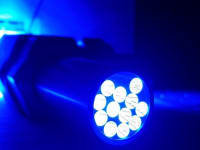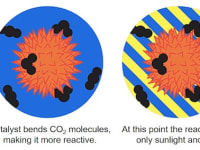

1 Nature of technology/product. The HI-Light reactor being developed at Cornell University is a solar-thermocatalytic “reverse combustion” technology that enables the conversion of CO2 and water to methanol and other high-value hydrocarbons. The innovative claim of the HI-Light reactor design derives from the concurrent optimization of light-coupling and catalyst availability. In the HI-Light design, the tubes are internal light-guiding rods with specially designed scattering surfaces that enable deep and efficient penetration of the solar radiation captured from a parabolic light concentrator into the reactor. The reagents and products flow through the shell outside the rods. The optical energy focused into the reactor interacts with our catalyst to convert incoming sequestered CO2. Photons with energies lower than those required for the catalytic reaction are used to provide thermal energy and ultimately the high temperatures required to ensure selectivity and efficiency of the reaction to revert CO2 to hydrocarbon fuels.
2 Market need and potential impact. The extraction and consumption of fossil carbon to run our daily lives accounts for over 6 billion metric tons of CO2 emissions each year driving climate change. Creating high value products from CO2 by using energy from all parts of the solar spectrum to photocatalytically produce liquid hydrocarbons at high temperatures, making CO2 capture and conversion economical. Our goal here is to enable the conversion of CO2 back to simple hydrocarbons, e.g. into methanol which has a typical spot price about 6x higher, potentially transforming carbon conversion into a profitable enterprise. We expect that advances from the proposed project will contribute significantly to the reduction of energy-related emissions, and have a positive impact on energy storage.
3 Competitive advantage and technological innovation. The major challenge of electrocatalysis is lowering the overpotential with breakthroughs in new catalysts. Up to now, product selectivity, lowering faradaic efficiency, and catalyst durability have been hard to achieve. The immense amount of power that it takes to drive the reaction leads to high operating costs. The unique design feature of our Hi-Light reactor is the optimized light delivery to both a fixed and fluidized nanostructured catalyst, coupled with solar thermal heating to reach elevated temperatures thereby enabling faster reaction rates and selectivity of higher hydrocarbons. The aim of our combined business and technical effort is to demonstrate that our HI-Light reactor enables substantially improved performance in terms of efficiency, volumetric productivity and mass of hydrocarbon per mass of catalyst per time relative to the state-of-the-art.
4 Potential interest from industry partners. The Cornell team has been working with Dimensional Energy (http://dimensionalenergy.net) a start-up directed by Jason Salfi and Clayton Poppe to commercialize this technology. In addition to advancing into Round 2 of the $20M NRG COSIA Carbon X-Prize, we have also had significant interactions with Shell Oil through the Shell GameChanger program.
Video
-
Awards
-
 2017 Grand Prize Winner
2017 Grand Prize Winner -
 2017 Top 100 Entries
2017 Top 100 Entries
Like this entry?
-
About the Entrant
- Name:Xiangkun Elvis Cao
- Type of entry:teamTeam members:Xiangkun (Elvis) Cao; Jessica Akemi Cimada da Silva; David Erickson; Tobias Hanrath; Jason Salfi; Clayton Poppe
- Software used for this entry:COMSOL
- Patent status:patented








